
Andreasson O.Iptables tutorial V1.1.9.2001
.pdf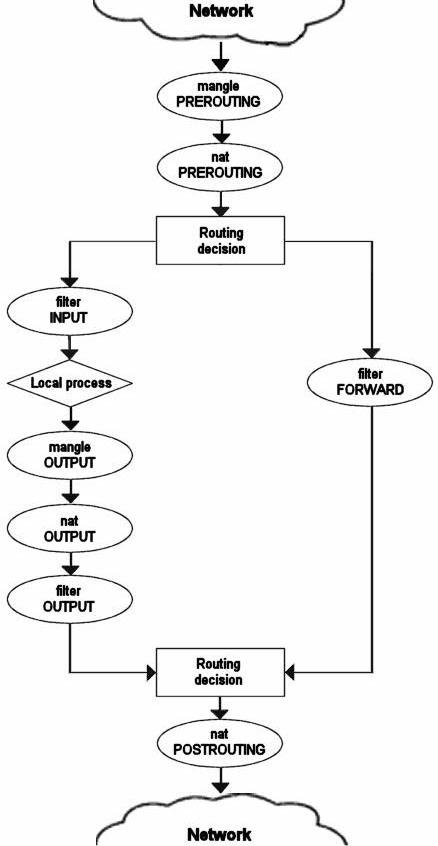
Iptables Tutorial 1.1.9 |
Página 171 |
Hopefully you got a clearer picture of how the packets traverses the built in chains now. All comments welcome, this might still be wrong or it might change in the future. If you feel that you want more information, you could use the rc.test-iptables.txt script. This test script should give you the necessary rules to test how the tables and chains are traversed.
http://people.unix-fu.org/andreasson/iptables-tutorial/iptables-tutorial.html |
21:25:51 10/06/2002 |

Iptables Tutorial 1.1.9 |
Página 172 |
Mangle table
This table should as we've already noted mainly be used for mangling packets. In other words, you may freely use the mangle matches etc that could be used to change TOS (Type Of Service) fields and so on.
It is strongly adviced that you don't use this table to do any filtering in, nor will any DNAT, SNAT or Masquerading work in this table.
Target's that only valid in the mangle table:
 TOS
TOS
 TTL
TTL
 MARK
MARK
The TOS target is used to set and/or change the Type of Service field in the packet. This could be used for setting up policies on the network regarding how a packet should be routed and so on. Note that this has not been perfected and is not really implemented on the internet and most of the routers don't care about the value in this field, and sometimes, they act faulty on what they get. Don't set this in other words for packets going to the internet unless you want to do routing decisions on it with iproute2.
The TTL target is used to change the TTL (Time To Live) field of the packet. We could tell packets to only have a specific TTL and so on. One good reason for this could be that we don't want to give ourself away to nosy Internet Service Providers. Some Internet Service Providers does not like users running multiple computers on one single connection, and there are some Internet Service Providers known to look for a single host generating many different TTL values, and takes this as one of many signs of multiple computers connected to a single connection.
The MARK target is used to set special mark values to the packet. These marks could then be recognised by the iproute2 programs to do different routing on the packet depending on what mark they have, or if they don't have any. We could also do bandwidth limiting and Class Based Queuing based on these marks.
Nat table
This table should only be used for NAT (Network Address Translation) on different packets. In other words, it should only be used to translate packets source field or destination field. Note that, as we have said before, only the first packet in a stream will hit this chain. After this, the rest of the packets will automatically have the same action taken on them as the first packet. The actual targets that does these kind of things are:
http://people.unix-fu.org/andreasson/iptables-tutorial/iptables-tutorial.html |
21:25:51 10/06/2002 |

Iptables Tutorial 1.1.9 |
Página 173 |
 DNAT
DNAT
 SNAT
SNAT
 MASQUERADE
MASQUERADE
The DNAT (Destination Network Address Translation) target is mainly used in cases such as when you have one IP and want to redirect accesses to the firewall to some other host on a DMZ for example. In other words, we change the destination address of the packet and reroute it to some other host.
SNAT (Source Network Address Translation) is mainly used for changing the source address of packets. This is mainly done to hide our local networks or DMZ, etcetera. A good example when this is very good is when we have a firewall that we know the outside IP address of, but need to change our local networks IP numbers to the same of the IP of our firewall. The firewall will with this target automatically SNAT and De-SNAT the packets, hence making it possible to make connections from the LAN to the Internet. If you're network uses 192.168.x.x netmask for example, the packets would never get back from the Internet because these networks are regulated to be used in LAN's by IANA.
The MASQUERADE target is used in exactly the same way as SNAT, but the MASQUERADE target takes a little bit more overhead to compute. The reason for this is that each time that the MASQUERADE target gets hit by a packet, it automatically checks for the IP address to use, instead of doing as the SNAT target does and just use an IP address submitted while the rule was parsed. The MASQUERADE target will on the other hand work properly with Dynamic IP addresses that you may be provided when you connect to the Internet with, for example PPP, SLIP or DHCP.
Filter table
The filter table is, of course, mainly used for filtering packets. We can match packets and filter them however we want, and there is nothing special to this chain or special packets that might slip through because they are malformed, etc. This is the place that we actually take action against packets and look at what they contain and DROP/ACCEPT depending on their payload. Of course we may do filtering earlier too, however, this is the place that was designed for it. Almost all targets are usable in this chain, however, the targets discussed previously in this chapter are only usable in their respective tables. We will not go into deeper discussion about this table though, as you already know, this is where we (should) do the main filtering.
rc.firewall file
This chapter will deal with an example firewall setup and how the script file could look. We have used one of the basic setups and dug deeper into how it works and what we do in it. This should be used to get a basic idea on how to solve different problems and what you may need to think about before actually putting your scripts into work. It could be used as is with some changes to the variables, but is not suggested since it may not work perfectly together with your network setup. As long as you have a very basic setup however, it will very likely run quite smooth with just a few fixes to it.
http://people.unix-fu.org/andreasson/iptables-tutorial/iptables-tutorial.html |
21:25:51 10/06/2002 |
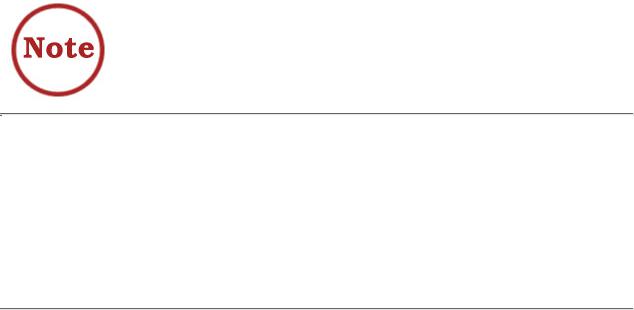
Iptables Tutorial 1.1.9 |
Página 174 |
note that there might be more efficient ways of making the ruleset, however, the script has been written for readability so that everyone can understand it without having to know too much BASH scripting before reading this
example rc.firewall
Ok, so you have everything set up and are ready to check out an example configuration script. You should at least be if you have come this far. This example rc.firewall.txt (also included in the Example scripts codebaseappendix) is fairly large but not a lot of comments in it. Instead of looking for comments, I suggest you read through the script file to get a basic hum about how it looks, and then you return here to get the nitty gritty about the whole script.
explanation of rc.firewall
Configuration options
The first section you should note within the example rc.firewall.txt is the configuration section. This should always be changed since it contains the information that is vital to your actual configuration. For example, your IP address will always change, hence it is available here. The $INET_IP should always be a fully valid IP address, if you got one (if not, then you should probably look closer at the rc.DHCP.firewall.txt, however, read on since this script will introduce a lot of interesting stuff anyways). Also, the $INET_IFACE variable should point to the actual device used for your internet connection. This could be eth0, eth1, ppp0, tr0, etcetera just to name a few possible device names.
This script does not contain any special configuration options for DHCP or PPPoE, hence these sections are empty. The same goes for all sections that are empty, they are however left there so you can spot the differences between the scripts in a more efficient way. If you need these parts, then you could always create a mix of the different scripts, or (hold yourself) create your own from scratch.
The Local Area Network section contains most of the configuration options for your LAN, which are necessary. For example, you need to specify the IP address of the physical interface connected to the LAN as well as the IP range which the LAN uses and the interface that the box is connected to the LAN through.
Also, as you may see there is a Localhost configuration section. We do provide it, however you will with 99% certainty not change any of the values within this section since you will almost always use the 127.0.0.1 IP address and the interface will amost certainly be named lo. Also, just below the Localhost configuration, you will find a brief section that pertains to the iptables. Mainly, this section only consists of the $IPTABLES variable, which will point the script to the exact location of the iptables application. This may vary a bit, and the default location when compiling the iptables package by hand is /usr/ local/sbin/iptables. However, many distributions put the actual application in another location such as /usr/sbin/iptables and so on.
http://people.unix-fu.org/andreasson/iptables-tutorial/iptables-tutorial.html |
21:25:51 10/06/2002 |

Iptables Tutorial 1.1.9 |
Página 175 |
Initial loading of extra modules
First, we see to it that the module dependencies files are up to date by issuing an /sbin/depmod -a command. After this we load the modules that we will require for this script. Always avoid loading modules that you do not need, and if possible try to avoid having modules lying around at all unless you will be using them. This is for security reasons, since it will take some extra effort to make additional rules this way. Now, for example, if you want to have support for the LOG, REJECT and MASQUERADE targets and don't have this compiled statically into your kernel, we load these modules as follows:
/sbin/insmod ipt_LOG /sbin/insmod ipt_REJECT /sbin/insmod ipt_MASQUERADE
Next is the option to load ipt_owner module, which could for example be used to only allow certain users to make certain connections, etcetera. I will not use that module in this example but basically, you could allow only root to do FTP and HTTP connections to redhat and DROP all the others. You could also disallow all users but your own user and root to connect from your box to the Internet, might be boring for others, but you will be a bit more secure to bouncing hacker attacks and attacks where the hacker will only use your host as an intermediate host. For more information about the ipt_owner match, look at the Owner match section within the How a rule is built chapter.
We may also load extra modules for the state matching code here. All modules that extend the state matching code and connection tracking code are called ip_conntrack_* and ip_nat_*. Connection tracking helpers are special modules that tells the kernel how to properly track the specific connections. Without these so called helpers, the kernel would not know what to look for when it tries to track specific connections. The NAT helpers on the other hand, are extensions of the connection tracking helpers that tells the kernel what to look for in specific packets and how to translate these so the connections will actually work. For example, FTP is a complex protocol by definition, and it sends connection information within the actual payload of the packet. So, if one of your hosts NAT'ed boxes connect to a FTP server on the internet, it will send its own local network IP address within the payload of the packet, and tells the FTP server to connect to that IP address. Since this local network address is not valid outside your own network, the FTP server will not know what to do with it and hence the connection will break down. The FTP NAT helpers do all of the translations within these connections so the FTP server will actually know where to connect. The same thing applies for DCC file transfers (sends) and chats. Creating these kind of connections requires the IP address and ports to be sent within the IRC protocol, which in turn requires some translation to be done. Without these helpers, some FTP and IRC stuff will work no doubt, however, some other things will not work. For example, you may be able to receive files over DCC, but not be able to send files. This is due to how the DCC starts a connection. First off, you tell the receiver that you want to send a file and where he should connect to. Without the helpers, the DCC connection will look as if it wants the receiver to connect to some host on the receivers own local network. In other words, the whole connection will be broken. However, the other way around, it will work flawlessly since the sender will (most probably) give you the correct address to connect to.
As of this writing, there is only the option to load modules which add support for the FTP and IRC protocols. For a long explanation of these conntrack and nat modules, read the Common problems and questionmarksappendix. There are also H.323 conntrack helpers within the patch-o-matic, as well as
http://people.unix-fu.org/andreasson/iptables-tutorial/iptables-tutorial.html |
21:25:51 10/06/2002 |
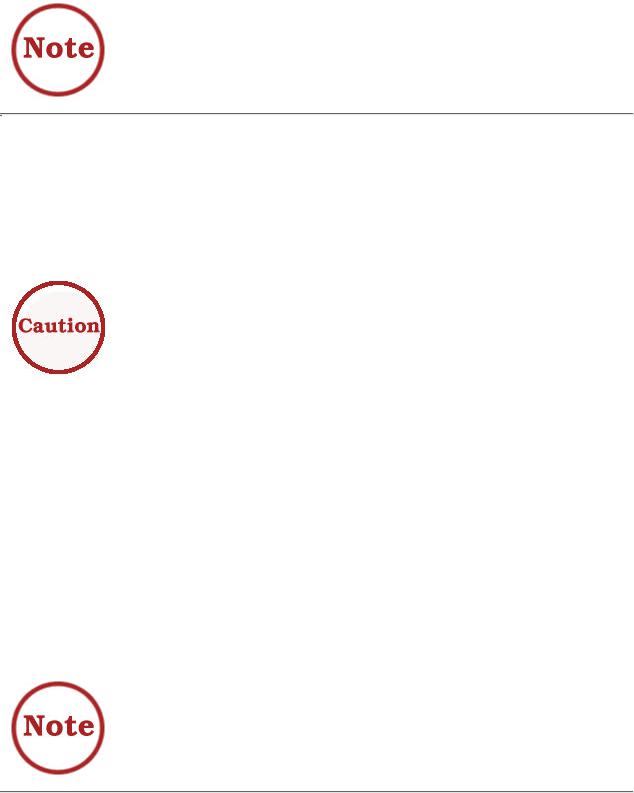
Iptables Tutorial 1.1.9 |
Página 176 |
some other conntrack helpers. To be able to use these helpers, you need to use the patch-o-matic and compile your own kernel. For a better explanation on how this is done, read the Preparations chapter.
Note that you need to load the ip_nat_irc and ip_nat_ftp if you want Network Adress Translation to work properly on any of the FTP and IRC protocols. You will also need to load the ip_conntrack_irc and ip_conntrack_ftp modules before actually loading the NAT modules. They are used the same way as the conntrack modules, but it will make it possible for the computer to do NAT on these two protocols.
proc set up
At this point we start the IP forwarding by echoing a 1 to /proc/sys/net/ipv4/ ip_forward in this fashion:
echo "1" > /proc/sys/net/ipv4/ip_forward
It may be worth a thought where and when we turn on the IP forwarding. In this script and all others within the tutorial, we turn it on before actually creating any kind of IP filters (ie, iptables rulesets). This will lead to a brief period of time where the firewall will accept forwarding any kind of traffic for everything between a millisecond to a minute depending on what script we are running and on what box. This may give malicious people a small timeframe to actually get through our firewall. In other words, this option should really be turned on after creating all firewall rules, however, I have chosen to turn it on here to maintain consistency with the script breakdown currently user.
In case you need dynamic IP next option, ip_dynaddr
support, for example if you use SLIP, PPP or DHCP you may enable the by doing the following :
echo "1" > /proc/sys/net/ipv4/ip_dynaddr
If there is any other options you might need to turn on you should follow that style, there's other documentations on how to do these things and this is out of the scope of this documentation. There is a good but rather brief document about the proc system available within the kernel, which is also available within the Other resources and links appendix. Also, it may be worth looking at that appendix in the future, in case there are possible additional links added to other and better resources of information.
The rc.firewall.txt script, and all others contained within this tutorial, do contain a small section of non-required proc settings. These may be a good starters to look at, however, do not turn these on before actually knowing what they mean.
Displacement of rules to different chains
http://people.unix-fu.org/andreasson/iptables-tutorial/iptables-tutorial.html |
21:25:51 10/06/2002 |
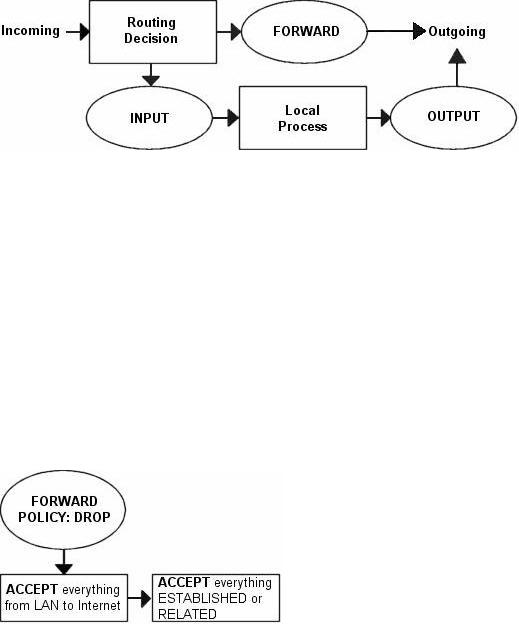
Iptables Tutorial 1.1.9 |
Página 177 |
This section will briefly describe my choices within the tutorial regarding user specified chains and some choices specific to the rc.firewall.txt script. Some of the paths I have chosen to go here may be wrong from one or another of aspect. I hope to point these aspects and possible problems out to you when and where they occur. Also, this section contains a brief look back to the Traversing of tables and chainschapter. Hopefully, this will remind you a little bit of how the specific tables and chains are traversed in a real live example.
I have displaced all the different user-chains in the fashion I have to save as much CPU as possible but at the same time put the main weight on security and readability. Instead of letting a TCP packet traverse ICMP, UDP and TCP rules, I simply match all TCP packets and then let the TCP packets traverse an user specified chain. This way we do not get too much overhead out of it all. The following picture will try to explain the basics of how an incoming packet traverses netfilter. With these pictures and explanations, I wish to explain and clarify the goals of this script. We will not discuss any specific details yet, but instead further on in the chapter. This is a really trivial picture in comparison to the one in the Traversing of tables and chainschapter where we discussed the whole traversal of chains and tables in depth.
Based upon this picture, let's make clear what our goals are. This whole example script is based upon the assumption that we are looking at a scenario containing one local network, one firewall and an Internet connection connected to the firewall. This example is also based upon the assumption that we have a static IP to the internet (as opposed to DHCP, PPP and SLIP and others). In this case, we also want to allow the firewall to act as a server for certain services on the internet, and we trust our local network fully and hence we will not block any of the traffic from the local network. Also, this script has as a main priority to only allow traffic that we explicitly want to allow. To do this, we want to set default policies within the chains to DROP. This will effectively kill all connections and all packets that we do not explicitly allow inside our network or our firewall.
In the case of this scenario, we would also like to let our local network do connections to the internet. Since the local network is fully trusted, we want to allow all kind of traffic from the local network to the internet. However, the Internet is most definitely not a trusted network and hence we want to block them from getting to our local network. Based upon these general assumptions, let's look at what we need to do and what we do not need to do.
http://people.unix-fu.org/andreasson/iptables-tutorial/iptables-tutorial.html |
21:25:51 10/06/2002 |

Iptables Tutorial 1.1.9 |
Página 178 |
First of all, we want the local network to be able to connect to the internet, of course. To do this, we will need to NAT all packets since none of the local computers have real IP addresses. All of this is done within the PREROUTING chain, which is created last in this script. This means that we will also have to do some filtering within the FORWARD chain since we will otherwise allow outsiders full access to our local network. We trust our local network to the fullest, and because of that we specifically allow all traffic from our local network to the internet. Since noone on the Internet should be allowed to contact our local network computers, we will want to block all traffic from the Internet to our local network except already established and related connections, which in turn will allow all return traffic from the Internet to our local network.
As for our firewall, we may be a bit low on funds perhaps, or we just want to offer a few services to people on the internet. Therefore, we have decided to allow HTTP, FTP, SSH and IDENTD access to the actual firewall. All of these protocols are available on the actual firewall, and hence it should be allowed through the INPUT chain, and we need to allow the return traffic through the OUTPUT chain. However, we also trust the local network fully, and the loopback device and IP address are also trusted. Because of this, we want to add special rules to allow all traffic from the local network as well as the loopback network interface. Also, we do not want to allow specific packets or packet headers in specific conjunctions, nor do we want to allow some IP ranges to reach the firewall from the Internet. For instance, the 10.0.0.0/8 address range is reserved for local networks and hence we would normally not want to allow packets from such a address range since they would with 90% certainty be spoofed. However, before we implement this, we must note that certain Internet Service Providers actually use these address ranges within their own networks. For a closer discussion of this, read the Common problems and questionmarkschapter.
Since we have an FTP server running on the server, as well as the fact we want to traverse as few rules as possible, we add a rule which lets all established and related traffic through at the top of the INPUT chain. For the same reason, we want to split the rules down into subchains. By doing this, our packets will hopefully only need to traverse as few rules as possible. By traversing less rules, we make the ruleset less timeconsuming for each packet, and reduce redundancy within the network.
In this script, we choose to split the different packets down by their protocol family, for example TCP, UDP or ICMP. All TCP packets traverse a specific chain named tcp_packets, which will contain rules for all TCP ports and protocols that we want to allow. Also, we want to do some extra checking on the TCP packets, so we would like to create one more subchain for all packets that are accepted for using valid port numbers to the firewall. This chain we choose to call the "allowed" chain, and should contain a few extra checks before finally accepting the packet. As for ICMP packets, these will traverse the icmp_packets chain. When we decided on how to create this chain, we could not see any specific needs for extra checks before allowing the ICMP packets through if we agree with the type and code of the ICMP packet, and hence we accept the directly. Finally, we have the UDP packets which needs to be dealt with. These packets, we send to the udp_packets chain which handles all incoming UDP packets.
http://people.unix-fu.org/andreasson/iptables-tutorial/iptables-tutorial.html |
21:25:51 10/06/2002 |
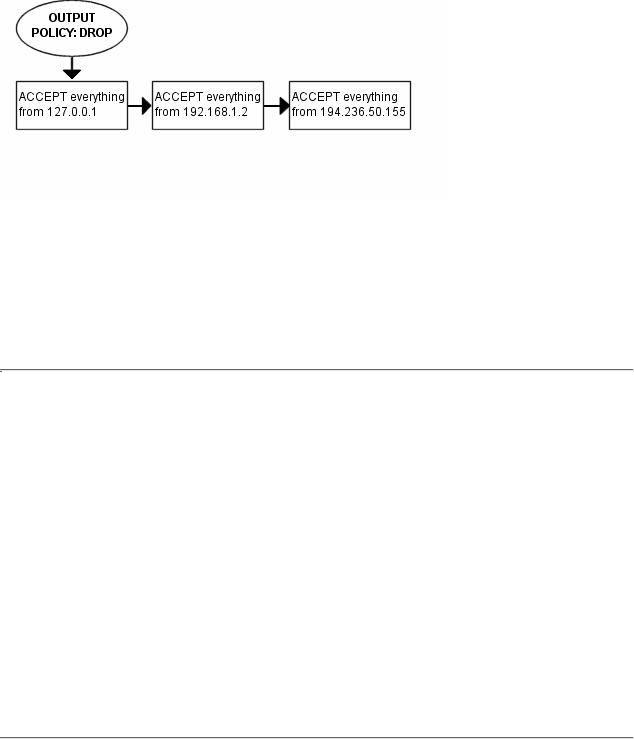
Iptables Tutorial 1.1.9 |
Página 179 |
All incoming UDP packets should be sent to this chain, and if they are of an allowed type we should accept them immediately without any further checking.
Since we are running on a relatively small network, this box is also used as a secondary workstation and to give some extra levy for this, we want to allow certain specific protocols to make contact with the firewall itself, such as speak freely and ICQ.
Finally, we have the firewalls OUTPUT chain. Since we actually trust the firewall quite a lot, we allow pretty much all traffic leaving the firewall. We do not do any specific user blocking, nor do we do any blocking of specific protocols. However, we do not want people to use this box to spoof packets leaving the firewall itself, and hence we only want to allow traffic from the IP addresses assigned to the firewall itself. We would most likely implement this by adding rules that ACCEPT all packets leaving the firewall in case they come from one of the IP addresses assigned to the firewall, and if not they will be dropped by the default policy in the OUTPUT chain.
Setting up the different chains used
So, now you got a small picture on how the packet traverses the different chains and how they belong together. You should also have a clear picture of the goals of this script. It is now about time that we take care of setting up all the rules and chains that we wish to create and to use, as well as all of the rulesets within the chains.
First of all, we set all the default policies on the different chains with a quite simple command.
iptables -P <chain name> <policy>
The default policy is used every time the packets don't match a rule in the chain. After this, we create the different special chains that we want to use with the -N command. The new chains are created and set up with no rules inside of them. The chains we will use are icmp_packets, tcp_packets, udpincoming_packets and the allowed chain for tcp_packets. Incoming packets on eth0, of ICMP type, will be redirected to the chain icmp_packets, of TCP type, will be redirected to tcp_packets and incoming packets of UDP type from eth0 go to udpincoming_packets chain.
INPUT chain
http://people.unix-fu.org/andreasson/iptables-tutorial/iptables-tutorial.html |
21:25:51 10/06/2002 |

Iptables Tutorial 1.1.9 |
Página 180 |
The INPUT chain as I've written it uses mostly other chains to do the hard work. This way we don't get too much load from the iptables, and it will work much better on slow machines which might otherwise drop packets at high loads.
We do certain checks for bad packets here. If you want to fully understand this, you need to look at the Appendices regarding state NEW and non-SYN packets getting through other rules. These packets could be allowed under certain circumstances but in 99% of the cases we wouldn't want these packets to get through. Hence, we log them to our logs and then we DROP them.
First of all we match all ICMP packets in the INPUT chain that come on the incoming interface $INET_IFACE, which in my case is eth0, and send those to the icmp_packets, which was previously described. After this, we do the same match for TCP packets on the $INET_IFACE and send those to the tcp_packets chain, and after this all UDP packets get sent to udpincoming_packets chain.
Finally, we check for everything that comes from our $LOCALHOST_IP, which would normally be 127.0.0.1 and ACCEPT all incoming traffic from there, do the same for everything to $LAN_IP, which in my case would be 192.168.0.0/24, and after this, something that some might consider a security problem, I allow everything that comes from my own Internet IP that is either ESTABLISHED or RELATED to some connection. Also, we allow broadcast traffic from our LAN. some applications depend on it such as Samba etc. These applications will not work properly without it.
Before we hit the default policy of the INPUT chain, we log it so we might be able to find out about possible problems and or bugs. Either it might be a packet that we just dont want to allow or it might be someone who's doing something bad to us, or finally it might be a problem in our firewall not allowing traffic that should be allowed. In either case we want to know about it so it can be dealt with. Though, we don't log more than 3 packets per minute as to not getting flooded with crap all over the log files, also we set a prefix to all log entries so we know where it came from.
Everything that hasn't yet been caught will be DROP'ed by the default policy on the INPUT chain. The default policy was set quite some time back, as you might remember.
The TCP allowed chain
If a packet comes in on eth0 and is of TCP type, it travels through the tcp_packets chain, if the connection is against an allowed port, we want to do some final checks on it to see if we actually do want to allow it or not.
First of all, we create the chain the same way as all the others. After that, we check if the packet is a SYN packet. If it is a SYN packet, it is most likely to be the first packet in a new connection so, of course, we allow this. Then we check if the packet comes from an ESTABLISHED or RELATED connection, if it does, then we, again of course, allow it. An ESTABLISHED connection is a connection that has seen traffic in both directions, and since we've got a SYN packet, and a reply to this SYN packet, the connection then must be in state ESTABLISHED. The last rule in this chain will DROP everything else. In this case this pretty much means everything that hasn't seen traffic in both directions, ie, we didn't reply to the SYN packet, or they are trying to start the connection with a non SYN packet. There is no practical use of not starting a connection with a SYN packet, except to portscan people
http://people.unix-fu.org/andreasson/iptables-tutorial/iptables-tutorial.html |
21:25:51 10/06/2002 |
